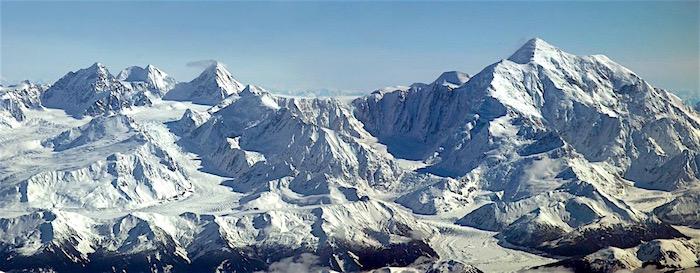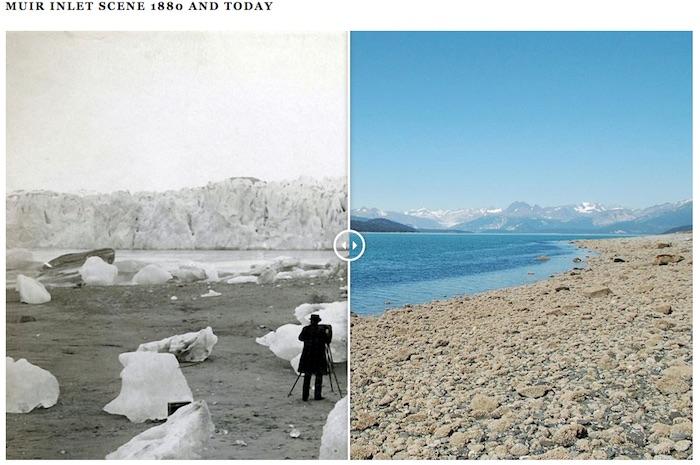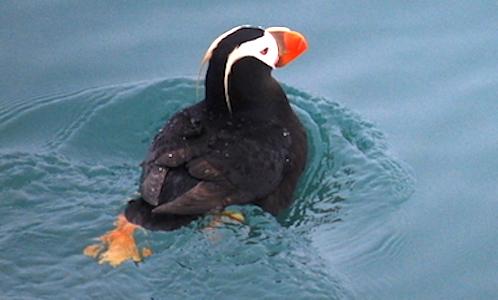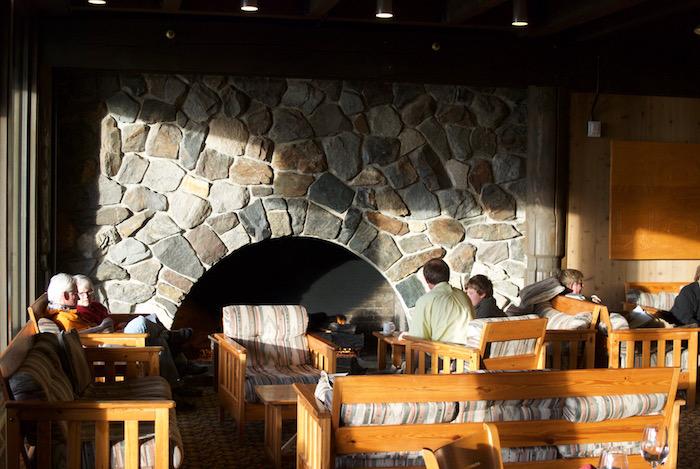
In 1879 John Muir described Mount Fairweather as "the noblest and most majestic in port and architecture of all the sky-dwelling company."/NPS
When John Muir traveled in 1879 to the landscape now embraced by Glacier Bay National Park and Preserve in Alaska, his great desire to see its bay and surrounding glaciers was confounded by overcast skies and rain with some snow mixed in. But when the weather took a change for the better, he was astounded by the view.
"While camp affairs were being attended to, I set out to climb a mountain for comprehensive views, and before I had reached a height of a thousand feet the rain ceased, and the clouds began to rise from the lower altitudes, slowly lifting their white skirts, and lingering in majestic, wing-shaped masses about the mountains that rise out of the broad, icy sea, the highest of all the white mountains, and the greatest of all the glaciers I had yet seen," he noted in his usual long and winding, richly descriptive sentences.
"Climbing higher for a still broader outlook, I made notes and sketched, improving the precious time while sunshine streamed through the luminous fringes of the clouds and fell on the green waters of the fiord, the glittering bergs, the crystal bluffs of the vast glacier, the intensely white, far-spreading fields of ice, and the ineffably chaste and spiritual heights of the Fairweather Range, which were now hidden, now partly revealed, the whole making a picture of icy wildness unspeakably pure and sublime."

Time-lapse photography shows the extent of glacial retreat from Muir Inlet. The photo on the left is thought to have been made by G.D. Hazard, a steamship passenger. The photo on the right was taken by Bruce Molina of the USGS.
Today, the head of Glacier Bay where Grand Pacific and Margerie glaciers calve into the bay is much farther back than it was in Muir's day, a result of glacial retreat. You can cruise to within sight of the snouts of those two glaciers on a concessionaire-operated ship that takes day tours the length of the 65-mile-long bay.
The park's summer season generally runs from Memorial Day Weekend through Labor Day. At least, that is, if you're planning to rely on the Glacier Bay Lodge in Gustavus for accommodations and meals. For those who fly into Gustavus for a visit, those who stay at the Glacier Bay Lodge typically stay for two-three days, while those who check into a lodge, B&B, or cabin in Gustavus generally stay 4-5 days.
For most visitors to Glacier Bay National Park, that 150-mile roundtrip day cruise is the highlight, and possibly the extent, of their visit. While cruise ships ply the bay's waters, they can' travel into arms of the bay and don't linger for long, giving passengers some glacier views before heading back out to sea. If you make your way to Gustavus and stay in the park lodge, or perhaps one of the bed-and-breakfast establishments nearby, the day cruise is a relaxing way to get a much closer look of the bay and its glaciers than that offered by cruise ships.
The much smaller day tour ship can get closer to the glaciers than the multi-story cruise ships, and the captain will slow the ship to allow the on-board interpreter -- usually a park ranger -- explain what you're seeing. And if you're a birder, well, there are few better ways to see birds in the park than aboard this small ship, or one of the smaller ships run by outfitters.
Birds teem to Glacier Bay, thanks in no small part to its nutrient-rich waters -- and insect-filled skies and seed-bearing forests in summer and early fall -- along with its plentiful, and diverse, breeding habitat. Bird habitat in the park ranges from rocky slopes revealed in the not-too-distant past by receding glaciers to coastal rain forest and muskeg landscapes. In slender arms of the park's waters, such as in Dundas Bay, extreme tidal fluctuations help churn up and reveal meals for many species. And the fact that the Pacific flyway makes a beeline across the park doesn't hurt the overall species diversity, either.

A Tufted puffin, Glacier Bay National Park/NPS
There are an estimated 240 bird species in the park, and it seems like you see most of them on the day cruise from Bartlett Cove to South Marble Island 15 miles north and on towards Johns Hopkins and Tarr inlets, roughly 50 more miles of water up bay.
While terrestrial birders spend much of their time scanning trees, bushes, and even power lines for birds, in Glacier Bay you're looking down onto the water's surface to see what might be bobbing along at least as much as gazing overhead to see what might be wheeling over your boat.
South Marble Island arguably is the high point for day birders thanks to the rich variety of species to be spotted there. You can see Common Murres and Pelagic Cormorants (Phalacrocorax pelagicus) clinging to the island's rocky cliffs, puffins zipping by through the air, murrelets diving for snacks, and Kittiwakes and Mew gulls circling overhead.
For the adventurous, hardy, and self-reliant, consider going on a paddle. Glacier Bay is considered by many as one of the top five kayaking destinations in the country thanks to the spectacular scenery, the marinelife, and the many inlets and hundreds of miles of coastline you can explore. You can rent a kayak in Bartlett Cove, join a guided tour, or, if you've got the skills and equipment, paddle off into the wilderness for a trip to the Beardslee Islands, which are within a day's paddle of the cove and so make for a quick, easy escape into the wilderness. Another option would be to hitch a ride on the day cruise to gain a start deeper in the park.
Hikers have a few options around the park lodge. There are four marked and maintained trails, and they range from 1 to 8 miles in length. The aptly named "Forest Trail" is a mile-long loop that winds through rain forest and along the beach of Bartlett Cove. The Bartlett River Trail runs four miles and offers the chance to spy moose, coyotes, and even brown bears on the beach.
The longest trail runs to Bartlett Lake and covers eight miles roundtrip. Weaving through the forest, this trail's payoff is solitude. Your final option is the Beach Trail, a mile-long route best taken at low tide so you can see what intertidal life remains behind the retreating waters. Just be sure to check the tide schedule so you don't have to walk through water on your return.
Fishing options abound, and you don't need to go far from the lodge to find success. Just head over to the mouth of the Bartlett River, which in late summer runs with pink, sockeye, and silver salmon.

After a day in the park, a seat in front of the fireplace in Glacier Bay Lodge is a cherished spot/Kurt Repanshek
If you'd prefer to save some money by not staying in the lodge, there is one "front country" campground in Glacier Bay, and it's located near the main dock and reached via a trail running about a quarter-mile to the south. The 33-site campground features a bear-proof food cache; a fire-pit with firewood, and; a warming shelter located in a very scenic setting along the shore. Though it's a walk-in campground, there are wheelbarrows you can borrow to haul your gear down the trail.
There is no charge for snagging a campsite. But you still must obtain a campground permit and attend a 30-minute orientation at the visitor center. Cooking and eating are only allowed in the intertidal zone (the area on the beach between the high and low tide lines).
Not to be missed during a visit to Bartlett Cove are two 20-foot, 2,000-pound red cedar Tlingit totems. They were erected in 2017 with the help of the Hoonah Indian Association. Elaborate carvings on the Eagle and Raven poles were designed by HIA to represent the various clans associated with Hoonah and Glacier Bay homeland. They completed Xunaa Shuká Hít, the Huna Tribal House that was dedicated in 2017.
For tribal members, Xunaa Shuká Hít, is an anchor to their Glacier Bay homeland. The facility serves as a gathering place where tribal members can reconnect with their treasured homeland through ceremonies, workshops, camps, tribal meetings and other events. It also provides park visitors with opportunities to learn about Huna Tlingit history, culture, and life ways.
For those in the Lower 48, this is not an easy park to reach. But it is a spectacular park to see, so we strongly recommend a visit longer than two or three days.
Traveler's choice for: Birding, glaciers, kayaking, backcountry travel



Add comment